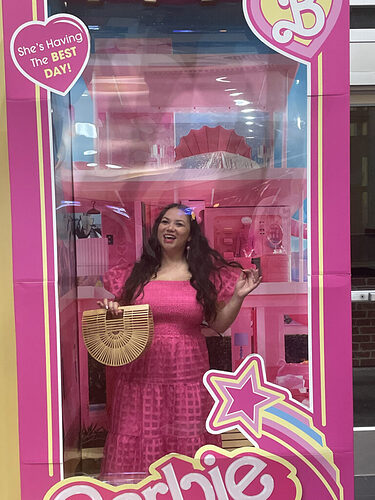Originally published at: The Billion Dollar Barbie: A Cinematic Odyssey of Empowerment and Nostalgia - People of Con

Author: Ariel Landrum
WARNING! SPOILERS AHEAD!
Barbie, the iconic doll from Mattel, has been a household name for over six decades. But this summer, thanks to the Margot Robbie-led movie, she’s again become America’s sweetheart. The film’s astounding success at the box office, earning over $1.03 billion globally, has solidified its place in cinematic history.
But what’s behind this Barbie renaissance?
From the toy shelves to the silver screen, Barbie’s transformation into a cultural icon is undeniable. This recent movie adaptation, helmed by the visionary Greta Gerwig and brought to life by the talented Robbie, has ignited conversations worldwide around difficult topics, including the challenges women face in patriarchy and the daily double standards they face. The “Barbenheimer” phenomenon, due to the film’s ingenious marketing strategy and its coincidental release date with Oppenheimer, played a pivotal role in its monumental success.
“Barbie represents the pinnacle of womanhood. She’s always been a mixed bag, reflecting societal values and norms. But there’s freedom in her world—a world where feminine energy is validated and amplified.”
The moment I heard about the release of the Barbie movie, a rush of childhood memories and nostalgia enveloped me. As someone who cherishes a collection of Barbies, especially my prized Wonder Woman Barbie—a delightful blend of my two beloved fandoms—I was filled with anticipation. Settling into my theater seat, the dimming lights signaled not just the beginning of a film but a journey into a narrative that would deeply resonate with my own experiences and beliefs.
The moment I heard about the release of the Barbie movie, a rush of childhood memories and nostalgia enveloped me. As someone who cherishes a collection of Barbies, especially my prized Wonder Woman Barbie—a delightful blend of my two beloved fandoms—I was filled with anticipation. I saw the movie with my friends, and we all wore shades of pink as a nod to the iconic doll. Before the film began, we captured the moment by taking a picture in a photo-op of a Barbie Box, making it seem as if we were toys ourselves. Settling into my theater seat, the dimming lights signaled not just the beginning of a film but a journey into a narrative that would deeply resonate with my own experiences and beliefs.
The film’s portrayal of Barbie was a revelation. While trailers hinted at her being the “Stereotypical Barbie,” the narrative revealed a character of depth, intelligence, strength, and emotion. Barbie’s journey in the real world, her interactions, and her self-discoveries were a mirror to the complexities every woman faces in today’s society.
Central to the film’s narrative was Barbie’s “relationship” with Ken, who, with his impeccable looks, epitomized the societal ideal of masculinity. Yet, the introduction of Allan, a character refreshingly devoid of societal expectations, added layers to the story. Allan, performed brilliantly by Michael Cera, emerged as a symbol of non-toxic masculinity—a nurturing, protective, and genuine man. Portrayed as a reflection of society’s expectations, especially regarding gender roles, this film challenges the notion of the idealized masculinity represented by Ken through the character of Allan.

The movie also showcases the compassion women often extend to men, even when not reciprocated. Gosling’s Ken, after learning about patriarchy in the real world, decides to implement it in Barbieland. This resulted in overthrowing the government, subjugating the Barbies, and seizing their home and property. Despite this despicable behavior, Barbie’s character is seen as understanding and forgiving through her apology to Ken. She takes the time to realize her actions resulted in him feeling small and wants to acknowledge the hurt she caused. However, Ken doesn’t apologize for the destruction he caused. Often, women find themselves forced to remove emotional hurt from insecure men who dole violence and refuse to acknowledge the pain they inflicted.
A scene that left an indelible mark on me was Barbie’s realization that she could be more than an aspirational figure. She could embrace the entirety of womanhood, with all its beauty and challenges. This powerful portrayal was a testament to the multi-dimensional nature of women, who are often confined to singular roles by society.
The film’s soundtrack was exceptional, narrating Barbie’s character arc from the ideal woman to experiencing existential crisis and dread, uncovering the truth of the real world, and finding out that she can be more than an object. With Ryan Gosling’s Ken having a solo performance with the now Billboard 100 charting song, “I’m Just Ken,” with one scene standing out—the Kens; it encapsulates the societal expectations placed on men and how ultimately, they do not serve them. Because the movie addresses how patriarchy doesn’t serve any gender, fans realize that men who dislike the Barbie movie see themselves as Ken, trapped in idealized masculinity. This has led to quite a few terminated relationships.
Even in a scene where all the Kens serenade their counterpart Barbies in what seems like a romantic ballad (“Push” by Matchbox Twenty), a veiled message highlights the violence women often experience in relationships with toxic men. This scene was a poignant reminder of women’s challenges, even in seemingly loving relationships.
Given the many scenes addressing profound societal issues, from Gloria’s (America Ferrera) monologue on unequal expectations of women to the first time Barbie experiences objectification, it’s no wonder the film’s overall impact has not gone unnoticed by the media. Critics and audiences alike have quickly recognized the depth and nuance with which the movie tackles these themes. Major publications have been unanimous in their praise of Barbie as well:
- NPR lauds Barbie’s portrayal as a multifaceted character who navigates modern womanhood while staying true to her essence.
- Out.com celebrates the film’s nuanced depiction of femininity, challenging and dismantling societal barriers.
- Rotten Tomatoes emphasizes the film’s cultural resonance, striking a chord with audiences across age groups.
- Elle offers insights into the film’s Easter eggs, adding depth and Barbie franchise lore to the narrative.
Barbie‘s success story isn’t confined to the US. Its empowerment, identity, and self-expression themes have found resonance globally, even in places like China, where Barbie isn’t a household name.
Reflecting on the film, I remember the discussions it sparked among my roommates and me. We delved into Barbie’s history, the film’s Easter eggs, and its profound impact on us. The narrative, with its childlike imagination, especially in scenes like the Ken fight sequence, was reminiscent of how a little girl would play with Barbie dolls, adding depth and reliability. We remarked how Robbie’s casting as Barbie is seen as deliberate and symbolic. Throughout her career, Robbie has been cast in roles that objectify her, essentially a “doll for men.” But in the Barbie movie, she emerges as an icon for women and girls.
Ultimately Barbie is more than just a cinematic masterpiece; it’s a movement. It challenges societal norms, celebrates femininity in all forms, and urges everyone to break free from societal chains. As a woman, I see it as a reflection of the challenges and joys of womanhood. It’s a journey of nostalgia, empowerment, and self-discovery that has left an indelible mark on me, and I believe it will do the same for viewers worldwide.
Key Points of this Review:
- Cinematic Success: The Margot Robbie-led movie’s success at the box office, earning over $1.03 billion globally, significantly revived interest in Barbie.
- Cultural Impact: The movie adaptation, directed by Greta Gerwig and starring Robbie, ignited global conversations about challenging topics, such as women’s difficulties in a patriarchal society and the double standards they encounter daily.
- Marketing Strategy: The “Barbenheimer” phenomenon, which arose due to the film’s marketing strategy and its coincidental release date with another movie, “Oppenheimer,” contributed to its monumental success.
- Narrative Depth: The film portrayed Barbie as a multi-dimensional character, challenging societal norms and expectations, especially regarding gender roles. The introduction of characters like Allan, who symbolizes non-toxic masculinity, and the portrayal of Ken’s character, added layers to the story.
- Soundtrack and Themes: The film’s soundtrack and themes of empowerment, identity, and self-expression resonated with audiences worldwide, leading to its global success.
- Societal Reflection: The movie reflects the challenges and joys of womanhood, urging viewers to challenge societal norms and celebrate femininity in all its forms.
MOVIE INFO
To live in Barbieland is to be a perfect being in a perfect place. Unless you have a full-on existential crisis. Or you’re a Ken.
- Rating: PG-13 (Suggestive References|Brief Language)
- Genre: Comedy
- Original Language: English
- Director: Greta Gerwig
- Producer: David Heyman, Margot Robbie, Tom Ackerley, Robbie Brenner
- Writer: Greta Gerwig, Noah Baumbach
- Release Date (Theaters): Jul 21, 2023 Wide
- Box Office (Gross USA): $351.4M
- Runtime: 1h 54m
- Distributor: Warner Bros. Pictures
- Production Co: Mattel, Heyday Films, NB/GG Pictures, LuckyChap Entertainment
- Sound Mix: Dolby Digital

